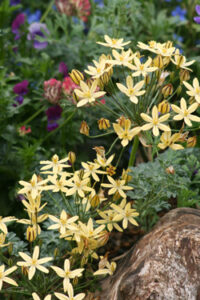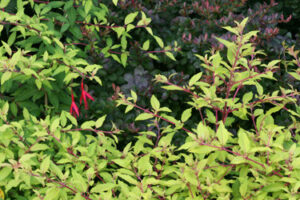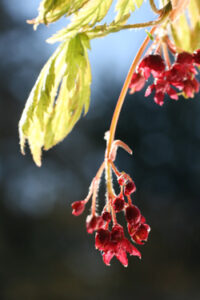Great Plant Picks program highlights selections that perform consistently in the Pacific Northwest
Over the last several years, many areas around the country have experienced prolonged droughts, excessively hot temperatures, and a noticeable decline in the population of pollinators. No one can deny that planting to increase insect diversity and lower water use is a good idea.
This year, the Great Plant Picks (GPP) education program is focusing on plants that improve our environment by highlighting those that are drought-tolerant, encourage pollinating insects, and garden-worthy natives of the Pacific Northwest.
GPP is the leading educational outreach program of the Elisabeth C. Miller Botanical Garden. The program began in 2000 with the goal of selecting a palette of plants that are consistent, reliable performers for the maritime Pacific Northwest.
An expert panel serves as the selection committee. These volunteers come from a diverse horticultural background and represent years of practical hands-on experience in the region. Committee members consist of retail and wholesale nursery representatives, garden designers, landscape architects, city park employees, arborists and representatives of public gardens.
Since the start of the program, more than 1,000 plants have been selected focusing on all kinds of garden and landscape situations. GPP selections are not necessarily the newest cultivar or variety but are the best performing selections available to the Northwest gardening community.
GPP has an extensive listing of plants that are well adapted to the modified Mediterranean climate of western Washington, Oregon and southwest British Columbia. Many of these choice ornamentals require little water once established. As water becomes more expensive in urban areas and restrictions on its use become more prevalent, native plants have become a useful alternative.

Some classic natives
A popular and easy place for nurseries and garden designers to connect with customers is to praise the virtues of our most garden-worthy West Coast natives.
Four classic natives that have proven ironclad in the landscape are Acer circinatum (vine maple), Vaccinium ovatum (evergreen huckleberry), Mahonia nervosa (Cascade Oregon-grape) and the beautiful early flowering Ribes sanguineum (flowering currant). These four natives are well behaved, easy to grow and provide food and shelter for wildlife, especially our native pollinator insects.
Of course, there are many more natives on the GPP website that fit well into a drought tolerant garden and often when we think of natives we immediately go to native trees and shrubs, but there is so much more that we can grow. One of most overlooked groups are native bulbs.
Several species of camas are native to the Northwest and form impressive stands in the wild during April and May. The tall flower spikes with their unique purple-blue coloring are as showy as any tulip and much more apt to return year after year.

Camassia quamash, tends to grow a little shorter than the other species with flowering stems 12 to 18 inches tall. There are a few selections of these species commercially available with ‘Orion’ being offered most often. ‘Orion’ is a robust grower with flowers nearly a midnight blue in color.
The taller growing Camassia leichtlinii ranges from 24 to 36 inches tall, typically lavender-blue. The cultivar ‘Cerulea’ has sky blue flowers on tall, strong stems. Once established these bulbs will produce full clumps and can reseed if allowed. Once introduced to the garden they will be a long-lasting perennial bulb. They will grow and flower best in full sun but can tolerate some light or open shade.
Another great group of western native bulbs has been confused with name changes coupled with a host of common names. What was once the genus Brodiaea is now divided into three separate genera, Triteleia, Dichelostemma, and Brodiaea.
All these genera bear their flowers on tall thin stems with a cluster of flowers on top in a loose umbel. These are generally late spring bloomers with the foliage emerging in late winter and withering into dormancy as the flower stems develop. Fortunately, the foliage is fine in texture and the withered leaves do not detract from the beauty of the flowers.
Triteleia ‘Corrina’ and ‘Queen Fabiola’ are widely available with flowers on stems 8 to 12 inches tall in rich purple tones, while Triteleia ixioides blooms a bright golden yellow on shorter stems 6 to 8 inches tall.
One of the most unusual and eye-catching flowers can be found on Dichelostemma ida-maia, the firecracker flower. Very tall, wiry stems reach 24 to 30 inches and are topped with hanging tubular flowers in bright red. Native to Northern California, it is found in sunny, dry slopes with the stems poking up through low shrubs and grasses.
Non-natives for pollinators

Native plants are ideally suited to native pollinators, but few of them are exclusive about their source of food. Non-invasive exotics can and should be an essential way we diversify our landscapes for pollinating insects.
Many common non-native plants are proven garden performers and excellent pollinator supporters. These non-natives can provide an important food source at times of the year when pollinators are active, yet native flowers may be scarce.
Through thoughtful selection, many of these plants can be chosen for good drought tolerance and pair well with natives. Early bloomers like Mahonia × media, Osmanthus × burkwoodii and Berberis darwinii add an additional food source in urban areas where early blooming natives like Oemleria cerasiformis (indian plum) and Rubus parviflorus (thimbleberry) are not as common.
The flowering season can also be stretched well into the fall with plants like Osmanthus heterophyllus (sweet olive) or Arbutus unedo (strawberry tree). The Osmanthus has tiny flowers that pack a powerful sweet fragrance that cannot be missed by bees or people and there are several cultivars like ‘Variegatus’ and ‘Purpurea’ that have colorful foliage.
Arbutus unedo produces long-lasting clusters of white urn-shaped flowers well into autumn. If given a mild winter, these flowers will develop into brightly colored orange and red fruits. Both plants have excellent drought tolerance and once established need little care.
In areas where water can be provided during prolonged dry periods, plants with an extended blooming season can be considered. Long bloomers are a magnet for bees, butterflies and hummingbirds for months on end.
One of the most floriferous of the long bloomers are the hardy fuchsias. The Northwest is an ideal climate for these exotic and beautiful sub-shrubs with dozens that will flourish in our maritime climate. Some of the hardiest are the Fuchsia magellanica selections and cultivars.

Fuchsia ‘David’ had tremendous flower power on a well-branched plant that is covered in flowers from mid-summer to late autumn with small, bright red, pendulous flowers with a royal purple center.
Fuchsia magellanica var. molinae ‘Alba’ is not white as one would expect, but a lovely pale bluish pink. This is one of the hardiest of the hardy fuchsias and one of the most vigorous cultivars available. In protected locations it can reach heights of 10 to 15 feet with hundreds of blooms over the season.
Fuchsia ‘Hawkshead’ is the closest you can get to a hardy pure white with gleaming pale blooms touched with just a hint of pink and green on the sepals. If you want something really bright, Fuchsia magellanica var. gracilis ‘Aurea’ is the fuchsia for you. Acid yellow foliage shines in full sun that will tone down to a bright chartreuse in partial shade. The red and purple flowers contrast brilliantly with the glowing leaves.
Trees that help pollinators
We do not often think of the average tree as providing food and habitat to pollinators unless we see it loaded with bloom. Ornamental cherries, magnolias and dogwoods would top this list, but when you realize that one of our prominent natives, Acer macrophyllum, or bigleaf maple, is insect pollinated you begin to see the hidden value of many ornamental trees.

Some of our most ornamental maples such as Acer circinatum, Acer japonicum and Acer palmatum all lure bees and other pollinators to their petite but nectar-rich flowers.
Linden trees are known for attracting masses of bees to pollinate their copious yet subtle flowers. If you want to create a beacon for pollinators, plant the large, beautiful, and aphid-resistant selection Tilia tomentosa ‘Sterling’, or Sterling silver linden. The fragrant flowers are partially hidden from view but can attract so many bees the tree will hum with the sound of their wings and the deep green leaves have a silvery-white underside that flashes with brilliance at the slightest breeze.
There are also many trees suitable for a smaller urban garden. Cornus mas, Crataegus × lavallei, Koelreuteria paniculata are three less commonly used species. All three tolerate tough city life in poor growing conditions yet can provide an essential food supply for pollinators in a concrete jungle.
Cornus mas (cornelian cherry) is tolerant of drought and is the first dogwood to bloom in late winter with clusters of small golden yellow flowers covering the branches.
Crataegus × lavallei (Lavalle’s hawthorn) is another extremely tough tree with white flowers in the spring that bees find irresistible. In late summer and early fall bright, red marble-sized fruit develop and colorfully hang on the tree until mid-winter.
Koelreuteria paniculata (golden rain tree) produces beautiful sprays of tiny yellow flowers in mid-summer. Later in the season they are followed by unusual balloon-like seed pods.
Where to learn more
All of these plants and much more can be found on the GPP website (www.greatplantpicks.org) It is easy for us to think of our landscapes and gardens as a part of a greater ecosystem. With little effort we can add an array of plant material that is not only beautiful but works towards a better planet.
Richie Steffen serves as the executive director of the Elisabeth C Miller Botanical Garden in Seattle, Washington, and oversees the Great Plant Picks educational outreach program. He can be reached at richies@millergarden.org.

